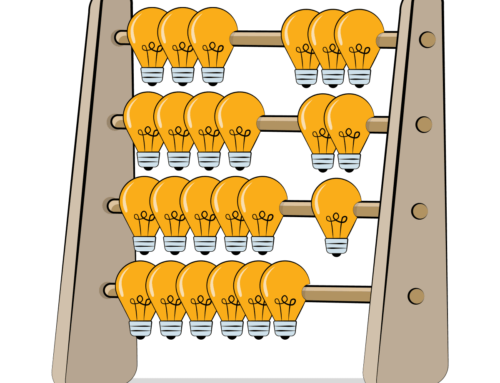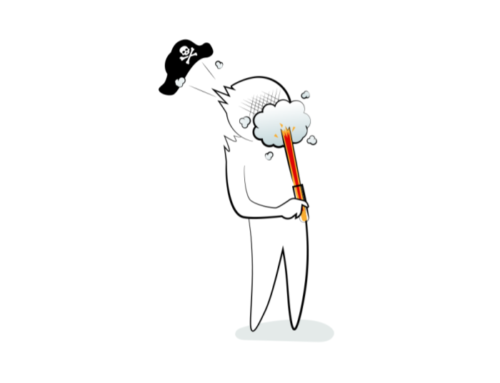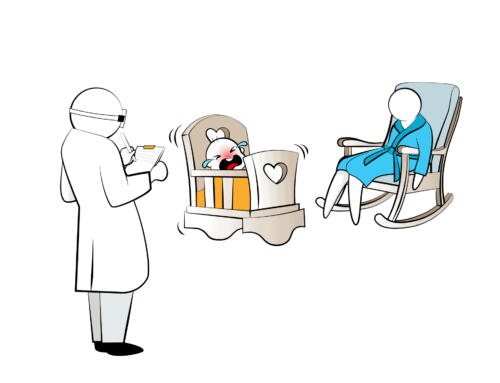Why Are You Starting Your Innovation Program from Scratch?
More and more companies are jumping on the innovation bandwagon and starting their own innovation program. It could be in the form of an accelerator, an innovation outpost in Silicon Valley, or a full, lean digital transformation of the company’s core processes.
But too many are falling into bad practices right away by adopting one of two extremes — either creating an innovation program from a blank slate (Tabula Rasa), or imitating another company’s program (Copy and Paste).
These are two of the most common mistakes in creating an innovation program for your business.
Tabula Rasa Innovation Programs
The first bad practice is starting from the premise that your company is a unique snowflake and will be fundamentally different than everyone else’s. This might lead you to believe there’s nothing worth learning about. Or maybe you’re better off just starting from scratch and dealing with the unique elements of your culture and organization.

Granted, everyone is a special snowflake, but there are some common patterns and obstacles that all companies share. While the solutions to those obstacles can differ wildly, the obstacles themselves only seem to vary in intensity between each innovation program.
These obstacles include:
- Apathy: Sometimes innovation just isn’t a priority.
- Skill gaps: Teams need a complete set of skills to get around the Build-Measure-Learn loop.
- Silos: Silos can limit a team’s capabilities and ensure that projects take a bit longer, or don’t happen at all.
- Dinosaurs: Every innovation ecosystem has dinosaurs making decisions based on years of experience that are no longer valid in the age of disruption.
- Waste: Time spent filling out paperwork is time not innovating.
- Fear: New ideas can be a recipe for disaster in a culture of naysayers.
- Loneliness: Without connection, there is no innovation.
- Vanity: Vanity metrics look good, but often represent activity without progress.
- Navel gazing: CEOs need to look outside the window and see the real world.
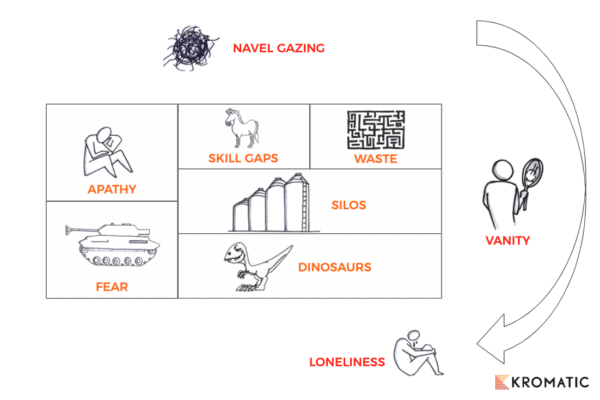
We can learn a lot from others without assuming that what worked for them will work for us. Expanding our network by reaching out to other thought leaders and VPs of innovation can provide a lot of value for very little effort. There are public conferences like Innov8rs and private groups of informal innovation leaders. (We try to introduce people to their peers in other organizations to help them get you started.)
By expanding your network and leveraging the power of peer-to-peer connections, your innovation program can gain:
- A boost to ideation.
- Someone to help point out blind spots.
- A bit of empathy when you hit roadblocks (you will hit roadblocks).
Bouncing Ideas around to Avoid Blind Spots
The more ideas, the better. Our first ideas are never our best ones.
By generating numerous ideas about possible innovation obstacles, you can avoid blind spots. There may be potholes in your innovation funnel that have been around so long you don’t see them anymore. So you just drive around them on autopilot.

We can’t see into our own blind spots. And sometimes we don’t even know we have a blind spot.
These are the unknown unknowns, or more infamously put, “the things we don’t know we don’t know.”
These “unobservables” can lead to the Dunning Kruger effect: you think you’re an “A” student, then you get a D- on the final exam.
We can use peers to point out assumptions that we should be challenging, and to point out potential biases in our experiments.
From Ideas to Action
Once you know where the problems are, in your ecosystem you can keep using your network to ideate solutions that other companies have found. There’s a better chance you won’t get stuck in a rut and miss an opportunity for excellence as you design your own innovation program.

You also benefit from the opportunity for a spontaneous collision. That’s when two (potentially terrible) ideas fit together to form something stronger and more powerful. Like Voltron, but with less swordplay and more ROI.
Think better by thinking together.
Someone to Lean On
Lastly, it’s good to have someone to talk with (or even just complain to).
Things will go wrong with your innovation program. Knowing that there’s someone else out there who has been through the same thing can help you retain your sanity.

It’s not just you. Transformation is hard, and big organizations can seem like a madhouse. Keep some friends outside the organization who can give you a dispassionate view (without forgetting the empathy).
Copy and Paste Transformation Programs
At the opposite end of the spectrum is just copying and pasting someone else’s innovation program, hoping to achieve the same impact.

This is a very dangerous approach. Even for companies in the same industry, copying someone else assumes that you have:
- The same market position
- The same core competencies
- The same strategy
- The same vision
- The same culture and values
It’s unlikely any of those things are true, let alone all of them.
While lean and agile principles like move fast and focus relentlessly on the customer remain relatively consistent, the practical applications change quite a lot.
When adopting someone else’s methodology, watch out for:
- Terminology
- Politics
- Immune system rejection
Terminology: Choose Your Words Wisely
Even subtle differences in terminology can make a big impact on transformation.

In one case, we saw an organization that had an aversion to “transformation,” but didn’t have an issue with changing the ways they work. In another case, “coaches” simply facilitated meetings at one company, while they functioned as experts in experiment and research methodology at another.
The term “lean” is one of the most commonly misunderstood terms. Lean principles are much more than just filling out a business model canvas. Without actually running experiments, the business model canvas never changes, and thus has no impact.
Don’t worry if terms like “lean” or “scrum” are tainted. Just use “agile” or “design thinking.” The main principles are the same, and it’s the impact that matters, not your favorite buzzword or your love for a certain ritual.
Politics: Beware of Infighting
Who owns the transformation? In a sufficiently large organization, there may be multiple transformation programs running concurrently, and they may not even know about each other.
Nothing is worse than trying to change the company for the better, but getting hung up on who gets the credit.

Do you want to have an impact, or do you want to get credit?
If you want to succeed, you need to make sure that everyone can be a hero in a transformation.
Immunity: “Not Invented Here” Syndrome
A lot has been said about the “corporate immune system” and its ability to reject new ideas. Sometimes this is understandable in context. Maybe the legal department is shutting down risky projects. Maybe IT wants to build something better than what they can purchase off the shelf. Maybe the marketing team doesn’t want to experiment with a prized brand.
The real danger is that ideas are dismissed out of hand just because they are someone else’s ideas. You need to make sure everyone has a role to play that they feel good about, and it’s their role to play. There must be internal ownership of the transformation. It shouldn’t be something copied from other companies or implemented by a batch of external consultants.
Finding the Middle Ground
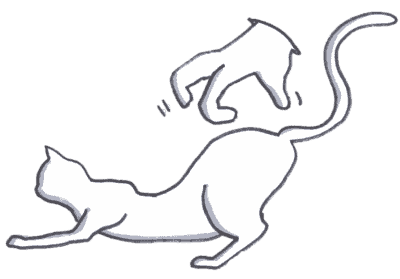 There is, of course, a sweet spot. Creating a tailored innovation program for your company and drawing ideas from existing innovation programs are not mutually exclusive practices.
There is, of course, a sweet spot. Creating a tailored innovation program for your company and drawing ideas from existing innovation programs are not mutually exclusive practices.
The trick is to understand what you want out of your program.
First, identify the obstacles in your innovation program and prioritize them. Don’t just launch an idea competition because everyone else is; launch one because your idea funnel is low and needs a kick start. Make sure you know exactly what obstacle you are addressing and how you will measure the impact of any solution.
Then you can pull the most helpful ideas from other programs to get you rolling. Just don’t stop there!
If you have a problem, metric, and solution, you’re just running an experiment. But instead of running an experiment on a product with customers, you’re running it on an ecosystem with intrapreneurs. (You can even use the standard lean experiment template or design an MVP of your solution using a storyboard.)
Measure the impact and be prepared to pivot by customizing your cut-and-paste solution for your company culture and situation.
And if you get stuck, well….we’re always listening.
Lessons Learned
- We can learn from others…
- …but we shouldn’t copy them.
- Use all the resources out there to chart your own course!



